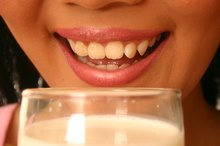A Diet for a Female Teenager With Low Blood Pressure
Low blood pressure may be normal for your teenager and not something that you should worry about as long as she eats a well-balanced diet, is healthy and energetic. However, you should immediately seek medical help if your teenager constantly complains of being tired, nauseous, has cold, clammy, pale skin, is always thirsty, feels dizzy, lacks concentration, has an irregular heartbeat or has a fainting spell. These symptoms of low blood pressure are cause for concern, according to the National Institutes of Health, and the underlying reason needs to be determined.
Low Blood Pressure in Teens
The American Academy of Pediatrics notes that orthostatic hypotension or low blood pressure is a possible cause of dizziness or fainting in teens brought about by an abrupt change in position. The low blood pressure may be caused by a teen's recent growth spurt accompanied by an increase in blood volume and a change in her center of gravity. Anorexia, an eating disorder, is another factor that may cause low blood pressure in a teen, according to an excerpt from “The Parent’s Guide to Eating Disorders” on the Eating Disorders website. Since dizziness and fainting due to low blood pressure may occur even before your teen has lost much weight, it is essential that you pay close attention to her dietary habits.
Recommended Dietary Allowances
How Much Protein Per Day for a Teenage Girl?
Learn More
Teenage girls needs to eat a healthy diet that meets requirements for all nutrients to maintain a normal blood pressure. Depending upon their activity level, the Dietary Guidelines for Americans recommends that teenage females between the ages of 14 to 18 years consume between 1,800 to 2,400 calories per day. The guidelines further recommend that 45 to 65 percent of the total calories come from carbohydrates, 25 to 35 percent from fat and 10 to 30 percent from protein. These can be simply tracked on an app like MyPlate. Some other nutrients that your teen needs on a daily basis include 700 micrograms of vitamin A, 15 micrograms of vitamin D, 1,300 milligrams of calcium, 15 milligrams of iron and less than 2,300 milligrams of sodium.
Diet For Low Blood Pressure
The American Academy of Pediatrics cautions that low blood pressure may occur if your teen has a low salt intake and drinks insufficient quantities of fluids. However, only increase salt intake if advised by your teen’s doctor, as a high salt intake can lead to high blood pressure. Encourage your teen to follow the general guidelines recommended by the NIH for treating low blood pressure. This includes drinking more water and eating a variety of fruits, vegetables, chicken, fish and whole grain carbohydrate foods to ensure that her diet contains all the required nutrients in recommended amounts.
A Healthy Diet
How Much Protein Does My Teenage Boy Need?
Learn More
USDA’s MyPlate recommends that teenage females between the ages of 14 and 18 who are moderately active should eat 2 ½ cups of vegetables, 1 ½ cups of fruits, 5 ounce equivalents of protein rich foods, 6 ounce equivalents of grains, 3 cups of milk and dairy products, and about 5 teaspoons of oil on a daily basis. By varying the vegetables, fruits, meat and grains in every meal you can ensure that she is eating a balanced diet. A healthy diet and a healthy weight generally help to maintain normal blood pressure.
Related Articles
References
Writer Bio
As a scientist and educator, Sukhsatej Batra has been writing instructional material, scientific papers and technical documents since 2001. She has a diverse scientific background, having worked in the fields of nutrition, molecular biology and biochemistry. Batra holds a PhD in foods and nutrition, and a certificate in professional technical communication.








